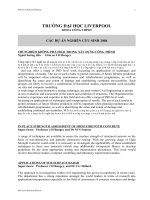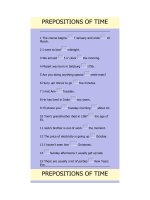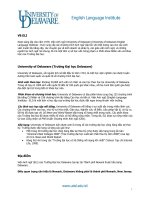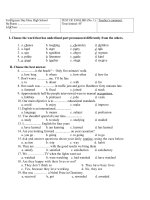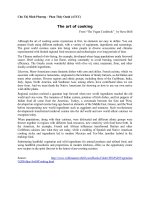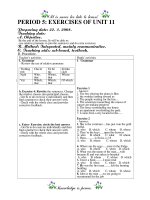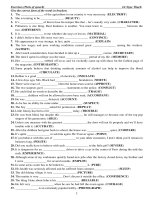Hierachy of desicion
Bạn đang xem bản rút gọn của tài liệu. Xem và tải ngay bản đầy đủ của tài liệu tại đây (329.68 KB, 5 trang )
8/15/16
LEVEL I Decision: Batch vs. Continuous
Hierarchy of decisions
Favor batch operation, if
1. Batch versus continuous
2. Input-output structure of the flowsheet
1. Production rate
3. Recycle structure of the flowsheet
4. General structure of the separation system
a. Vapor recovery system
b. Liquid recovery system
5. Heat-exchanger network
Ch. 4
Ch.5
a ) less than 10×10 6 lb/yr (sometimes)
b ) less than
1×10 6
lb/yr (usually)
c ) multi-product plants
2. Market force
a ) seasonal production
Ch.6, Ch.7, Ch.16
b) short production lifetime
3. Scale-up problems
a ) very long reaction times
b ) handling slurries at low flow rates
c ) rapidly fouling materials.
Hierarchy of decisions
1. Batch versus continuous
2. Input-output structure of the flowsheet
3. Recycle structure of the flowsheet
4. General structure of the separation system
a. Vapor recovery system
b. Liquid recovery system
5. Heat-exchanger network
Heuristics:
Ch. 4
Ch.5
Ch.6, Ch.7, Ch.16
Recover more than 99% of all valuable materials.
assume
Completely recover and recycle all
valuable reactants
LEVEL 2 DECISIONS:
DECISIONS FOR THE INPUT/OUTPUT STRUCTURE
2 ) Should we remove or recycle a reversible by-product?
• Flowsheet Alternatives
3 ) Should we use a gas recycle and purge stream?
(1)
Feed streams
4 ) Should we not bother to recover and recycle some reactants?
Products
by-products
no reactants
Process
(2)
Feed streams
1 ) Should we purify the feed streams before they enter the process?
Purge
Process
Products
By-Products
5 ) How many product streams will there be?
6 ) What are the design variables for the input/output structure?
What economic trade-offs are associated with these variables?
Products
•
•
•
•
&
PROCESS
•
•
Feeds
By products
reasons:
a. inexpensive reactants, e.g. Air, Water.
b. gaseous reactants + (inert gaseous feed impurity or inert gaseous
reaction by-product)
CuuDuongThanCong.com
OR
Feeds
•
•
•
PROCESS
/>
•
•
•
Purge
Products
&
By products
1
8/15/16
1 ) Purification of Feeds (Liquid/Vapor)
Heat
Compressor
H2, CH4
Purge
H2
Heat
CH4
Reactor
3 ) If a feed impurity is catalyst poison, remove it.
5 ) If a feed impurity is present as an azeotrope with a reactant, often it is
better to process the impurity.
6 ) If a feed impurity is inert, but it is easier to separate from the product than
the feed, it is better to process the impurity.
Toluene
Heat
Coolant
Heat
Toluene
Flash
500 psia
Benzene
Recycle
4 ) If a feed impurity is present in a gas feed, as a first guess, process the
impurity.
95°F
1150° ~ 1300°
2 ) If a feed impurity is present in large amount, remove it.
H2, CH4
Product
1 ) If a feed impurity is not inert and is present in significant quantities,
remove it.
Dipheny1
7 ) If a feed impurity in a liquid feed stream is also a byproduct or a product
component, usually it is better to feed the process through the separation
system.
Toluene
A HIERARCHICAL APPROACH
3 ) Gas Recycle and Purge
“Light” reactant
+
“Light” feed impurity, or
“Light” by-product produced by a reaction
Whenever a light reactant and either a light feed impurity or a light byproduct boil lower than propylene (-55ºF), use a gas recycle and purge
stream.
Lower boiling components normally cannot be condensed at high pressure
with cooling water.
Toluene + H2 ® Benzene + CH4
2 Benzene
Diphenyl + H2
1150 ° F ~ 1300 ° F
500 psia
5 ) Number of Product Streams
TABLE 5.1-3
Destination codes and component classifications
Destination code
1. Vent
2. Recycle and purge
3. Recycle
4 ) Do not recover and recycle some reactants which are
inexpensive, e. g. air and H2O.
We could try to make them reacted completely, but often we feed them as an excess
to try to force some more valuable reactant to completion.
4.None
5.Excess - vent
6.Excess - vent
7.Primary product
8.Fuel
9.Waste
Component classifications
Gaseous by-products and feed impurities
Gaseous reactants plus inert gases and/or gaseous by-products
Reactants
Reaction intermediates
Azeotropes with reactants (sometimes)
Reversible by-products (sometimes)
Reactants-if complete conversion or unstable reaction intermediates
Gaseous reactant not recovered or recycles
Liquid reactant not recovered or recycled
Primary product
By-products to fuel
should be
By-products to waste treatment
minimized
A ) List all the components that are expected to leave the reactor. This list includes all
the components in feed streams, and all reactants and products that appear in every
reaction.
B ) Classify each component in the list according to Table 5.1-3 and assign a destination
code to each.
C ) Order the components by their normal boiling points and group them with
neighboring destinations.
D ) The number of groups of all but the recycle streams is then considered to be the
number of product streams.
CuuDuongThanCong.com
/>
2
8/15/16
EXAMPLE
b.p.
A
B
C
D
E
F
G
H
I
J
Waste
Waste
Recycle
Fuel
Fuel
Primary product
Recycle
Recycle
Valuable By-product
Fuel
5
A + B to waste ①
H2 , CH4
1
D + E to fuel stream # 1 ②
F
to primary product ③
(storage for sale)
H2
CH4
Benzene
Toluene
Diphenyl
Recycle and Purge
Recycle and Purge
Primary Product
Recycle
Fuel
Process
1
H2
CH 4
Benzene
Toluene
Diphenyl
Temperature
Pressure
FH2
FM
0
0
0
100
550
Benzene
Diphenyl
4
2
3
0
0
0
P B/S
0
100
15
0
0
PB
0
0
100
15
①
where S = 1 - 0.0036/(1 -x) 1.544
②
③
FIGURE 5.2-1
Stream table
4
5
0
FE
0
F M + P B/S
0
0
0
0
P B(1 - S)/(2S) 0
100
100
15
465
F H2 = F E + P B(1 + S)/2S
F M = (1 - y FH)[F E + P B(1 + S)/S]/ y FH
① Purge : H2 , CH4
H2 , CH4
Toluene
Process
2
Production rate = 265
Design variables: F E and x
Component
I to valuable by-product (storage for sale) ④
J to fuel stream # 2 ⑤
EXAMPLE
b.p.
-253°C
-161
80
111
253
Toluene
Purge
H2 , CH4
3
F G = F H2 + F E
.
② Benzene
③ Diphenyl
REACTOR PERFORMANCE
Alternatives for the HDA Process
1. Purify the H2 feed stream.
2. Recycle diphenyl
3. Purify H2 recycle stream.
STOICHIOMETRIC FACTOR
(SF)
The stoichiometric moles of reactant
required per mole of product
CuuDuongThanCong.com
Conversion (x)
= (reactant consumed in the reactor)/(reactant
fed to the reactor)
Selectivity (S)
=[(desired product produced)/(reactant
consumed in the reactor)]*SF
Reactor Yield (Y)
=[(desired product produced)/(reactant fed to
the reactor)]*SF
Material Balance of Limiting Reactant in Reactor
Toluene
unconverted
(1-x) mole
Toluene
feed
(1 mole)
Toluene
converted
x mole
/>
recycle
Benzene
produced
Sx mole
Diphenyl
produced
(1-S)x / 2
3
8/15/16
Gas recycle
Purge
H2 , CH4
Toluene 1 x
Benzene Sx
H2 , CH4
1
2
Diphenyl (1 S) x
Reactor
system
Toluene
POSSIBLE DESIGN VARIABLES FOR LEVEL 2
Benzene
Sx
Separation
system
x
Dipheny1
1
(1
2
1 x
For complex reactions:
Reactor conversion (x), reaction temperature (T) and pressure (P).
S)x
If excess reactants are used, due to reactant not recovered or gas recycle and purge, then
the excess amount is another design variable.
Toluene recycle
Material Balance of the Limiting
Reactant (Toluene)
Assumption: completely recover and recycle the limiting reactant.
EXAMPLE
PROCEDURES FOR DEVELOPING OVERALL
MATERIAL BALANCE
1 ) Start with the specified production rate.
relation
known
3 ) Calculate the impurity inlet and outlet flows for the feed streams where the reactant are
completely recovered/recycled.
4 ) Calculate the outlet flows of reactants in terms of a specific amount of excess for streams
where reactants are not recovered and recycled (recycle and purge, or air, or H2O)
SS( x )
= selectivity = given
PPBB ( mol/hr ) = production rate of Benzene =given
ÚFFT ( mol/hr ) = toluene feed to process ( limiting reactant ) = PB /S
PR , CH 4
= methane produced in reaction = FFT = PB /S
ÚPD
design
variable
= diphenyl produced in reaction = FFT (1 - S /2 ) = (PB /S)(1 - S /2 )
Let FFEE = excess amount of H2 in purge stream= PH 2
FE +
Ú
( PB /S ) - [( PB /S )( 1 - S )/2]
purge rate
of H2
= yFH FG
disapp. in reaction
FH 2
where
FG = make-up gas stream flowrate (unknown)
yFH =
5 ) Calculate the inlet and outlet flows for the impurities entering with the reactant streams
in Step 4).
mole fraction of H2 in FG
( known )
Let PCH 4 = purge rate of CH4
methane in purge stream
( 1 - yFH ) FG + PB /S = PCH 4
Ú
Normally, it is possible to develop expressions for overall MB in terms of design
variables without considering recycle flows.
Benzene , PB
Diphenyl , PD
Process
design variable
given
2 ) From the stoichiometry (and, for complex reactions, the correlation for product
distribution) find the by-product flows and the reactant requirements (in terms of the
design variables).
Purge ; H2 , CH4 , PG
FG , H2 , CH4
FFT , Toluene
methane product in reaction
methane in feed
Ú PG = total purge rate = PH2 + PCH4 = FE + (1 - yFH) FG + PB/S
= FG + ( PB/S )[( 1 - S )/2]
Known : yFH
PB
Design Variables :
y
x, PH
Define
yPH =
purge composition of H2 = PH2/PG = FE/PG
S(x)
P B/S
F FT(1-S)/2
FFT
PD
PB[1-(1- yPH)(1-S)/2
S( yFH - yPH)
design
variable
It can be derined that
FG =
Known :
FCH4
PB [ 1- (1- yPH)(1-S)/2 ]
S (yFH - yPH)
F CH4+P B/S
S (x)
x
PB
PCH4
FCH4+PB/S
FN2+FCH4
CuuDuongThanCong.com
FG
FG
F G+(P B/S)(1-S)/2
6 ) ECONOMIC POTENTIAL AT LEVEL 2
EP2 = Annual profit if capital costs and utility costs are excluded
FFT
[(1- yFH)/ yFH]FH2
FE+[PB(1+S)/2S]
FCH4
FH2
PD
PCH4+FE
PG
PB/S
(PB/S)[(1-S)/2]
FE
PG
PCH4
design variable
Design Variable :
yFH
1- yPH
yPH F H2
F E+P B(1+S)/2S
FH2
FE
(PH2) P G yPH
= Product Value + By-product Value - Raw-Material Costs
[EXAMPLE] HDA process
4 ´10^6
2 ´10^6
$/yr
-2 ´10^6
-4 ´10^6
yPH
0.1
0.3
Ỵ
0.5
0.1
/>
0.1
0.7
0.9
4
8/15/16
Douglas, J. M., “Process Synthesis for Waste
Minimization.” Ind. Eng. Chem. Res., 1992, 31, 238-243
If we produce waste by-products, then we have negative byproduct values.
Solid waste : land fill cost / lb
Contaminated waste water :
- sewer charge : $ / 1000 gal. (e.g. $0.2 / 1000 gal)
- waste treatment charge :
$ / lb BOD ´ lb BOD / lb organic compound (e.g. $0.25 /lb BOD)
Solid or liquid waste to be incinerated :
$ 0.65 / lb
BOD - biological oxygen demand
CuuDuongThanCong.com
/>
5
